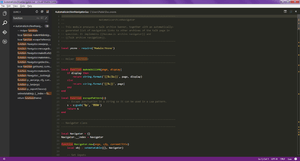Visual Studio Code
|
| |
|
Visual Studio Code running on Windows 7, with "Search" function activated | |
| Developer(s) | Microsoft |
|---|---|
| Initial release | April 29, 2015 |
| Stable release | 1.7.2 (24 November 2016) [±][1] |
| Repository |
github |
| Development status | Active |
| Operating system | Windows 7 or later, OS X 10.10 or later, Linux |
| Platform | IA-32, x64 |
| Size |
|
| Available in | English, French, German, Italian, Japanese, Korean, Russian, Spanish, Chinese (both simplified and traditional) |
| Type | Source code editor, debugger |
| License |
|
| Website |
code |
Visual Studio Code is a source code editor developed by Microsoft for Windows, Linux and macOS. It includes support for debugging, embedded Git control, syntax highlighting, intelligent code completion, snippets, and code refactoring. It is also customizable, so users can change the editor's theme, keyboard shortcuts, and preferences. It is free and open-source,[5][6] although the official download is under a proprietary license.[4]
Visual Studio Code is based on Electron, a framework which is used to deploy Node.js applications for the desktop running on the Blink layout engine. Although it uses the Electron framework,[7] the software is not a fork of Atom, it is actually based on Visual Studio Online's editor (codename "Monaco").[8]
History
Visual Studio Code was announced, and a preview was released, on April 29, 2015 by Microsoft at the 2015 Build conference.[9]
On November 18, 2015, Visual Studio Code was released under the MIT License and its source code posted to GitHub. Extension support was also announced.[5]
On April 14, 2016, Visual Studio Code graduated the public preview stage and was released to web.[10]
Features
Visual Studio Code is a source code editor. It supports a number of programming languages and a set of features that may or may not be available for a given language, as shown in the following table. Many of Visual Studio Code features are not exposed through menus or the user interface. Rather, they are accessed via the command palette or via a .json file (e.g., user preferences).[11] The command palette is a command-line interface. However, it disappears if the user clicks anywhere outside it or presses a key combination on the keyboard to interact with something outside it. This is true for time-taking commands as well. When this happens, the command in progress is canceled.
In the role of a source code editor, Visual Studio Code allows changing the code page in which the active document is saved, the character that identifies line break (a choice between CR and CRLF), and the programming language of the active document.
| Features | Languages |
|---|---|
| Syntax highlighting | Batch, C++, Clojure, CoffeeScript, DockerFile, Elixir, F#, Go, Jade template language[12] (not to be confused with JADE),[13] Java, HandleBars, Ini, Lua, Makefile, Objective-C, Perl, PowerShell, Python, R, Razor, Ruby, Rust, SQL, Visual Basic, XML |
| Snippets | Groovy, Markdown, Nim,[14] PHP, Swift |
| Intelligent code completion | CSS, HTML, JavaScript, JSON, Less, Sass, TypeScript |
| Refactoring | C#, TypeScript |
| Debugging |
Visual Studio Code can be extended via plug-ins.[15] This includes additions to the editor[16] and language support.[11]
Data collection
Visual Studio Code collects usage data and sends it to Microsoft, although this telemetry reporting can be disabled.[17] The data is shared among Microsoft-controlled affiliates and subsidiaries and with law enforcement per the privacy statement.[18]
References
- ↑ "Visual Studio Code 1.7.2". FileHippo. 24 November 2016.
- ↑ "LICENSE.txt". github.com/Microsoft/vscode. Microsoft. 17 November 2015.
- ↑ "Download Visual Studio Code". code.visualstudio.com. Microsoft. Retrieved 16 August 2016.
- 1 2 "Microsoft Software License Terms". code.visualstudio.com. Microsoft. Retrieved 16 August 2016.
- 1 2 "Visual Studio now supports debugging Linux apps; Code editor now open source". Ars Technica. Retrieved 18 November 2015.
- ↑ Lardinois, Frederic (April 29, 2015). "Microsoft Launches Visual Studio Code, A Free Cross-Platform Code Editor For OS X, Linux And Windows". TechCrunch.
- ↑ "Microsoft's new Code editor is built on Google's Chromium". Ars Technica. Retrieved 18 November 2015.
- ↑ "Monaco Editor". microsoft.github.io/monaco-editor.
- ↑ Montgomery, John (April 29, 2015). "BUILD 2015 News: Visual Studio Code, Visual Studio 2015 RC, Team Foundation Server 2015 RC, Visual Studio 2013 Update 5".
- ↑ "Visual Studio Code editor hits version 1, has half a million users". Ars Technica. Condé Nast. 15 April 2016.
- 1 2 3 "Language Support in Visual Studio Code". Visual Studio Code. October 10, 2016. Retrieved 2016-10-12.
- ↑ jade-lang
.com - ↑ "standalone-languages/jade.ts". Microsoft/vscode GitHub repository. Microsoft. 13 November 2015.
- ↑ "Nim Wiki: Editor Support".
- ↑ "Extending Visual Studio Code". Visual Studio Code. October 10, 2016. Retrieved 2016-10-12.
- ↑ "Managing Extensions in Visual Studio Code". Visual Studio Code. October 10, 2016. Retrieved 2016-10-12.
- ↑ "Visual Studio Code FAQ". Archived from the original on 28 August 2016. Retrieved 4 November 2016.
VS Code collects usage data and sends it to Microsoft to help improve our products and services. Read our privacy statement to learn more. If you don’t wish to send usage data to Microsoft, you can set the telemetry.enableTelemetry setting to false.
- ↑ "Microsoft Enterprise and Developer Privacy Statement". Archived from the original on 4 November 2016. Retrieved 4 November 2016.
